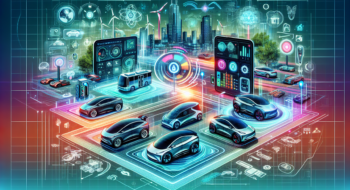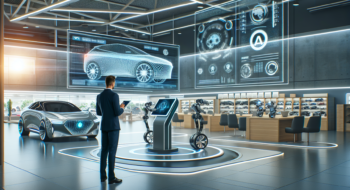The automotive industry is undergoing a transformative shift as it navigates rapid advancements in technology and changing consumer demands. In this dynamic landscape, trends such as electrification, advanced connectivity, and autonomous driving are reshaping vehicle design and production processes. As manufacturers adapt to sustainability goals and the digitalization of services, understanding these emerging trends is crucial for stakeholders. This article delves into the key developments driving innovation in the automotive sector, offering insights into how companies are positioning themselves for success in an ever-evolving market.
Electrification: A New Era for Vehicles
As we delve deeper into the automotive revolution, electrification stands out as a pivotal trend reshaping the future of driving. With governments pushing for stricter emissions regulations, consumers increasingly demanding greener alternatives, and technology making significant strides, electric vehicles (EVs) are finally taking center stage.
Sales figures reflect this shift—worldwide EV sales surged past 2 million in 2021, significantly rising over previous years. Companies like Tesla have paved the way for this electric renaissance, but traditional manufacturers such as Ford, Volkswagen, and General Motors have rapidly adapted, launching ambitious EV portfolios.
Battery Technology and Infrastructure Growth
And it doesn’t stop there. As confident as we are in this electric evolution, advancements in battery technology are vital to its success. Manufacturers increasingly invest in research to develop high-performance batteries that offer longer ranges and shorter charging times. Solid-state batteries, for example, promise to revolutionize the market by providing greater energy density and enhanced safety.
However, a vehicle is only as good as its ability to recharge. The growth of charging infrastructure is equally essential to facilitate EV adoption. Public and private investments are being funneled into expanding networks of charging stations, ensuring drivers don’t find themselves stranded with a depleted battery.
Advanced Connectivity: The Road to Digital Integration
Let’s shift gears to another captivating trend: advanced connectivity. The contemporary car is rapidly evolving from a simple means of transport to a digital extension of our lives. The internet of things (IoT) is transforming vehicles into smart hubs, allowing drivers to stay continuously connected.
Equipped with cutting-edge infotainment systems, cars now offer real-time navigation, entertainment options, and remote monitoring capabilities. This integration not only enhances the user experience but also promotes safety through features like automatic notifications for maintenance needs.
Vehicle-to-Everything (V2X) Communication
Beyond individual vehicle connectivity, we are witnessing the emergence of Vehicle-to-Everything (V2X) communication systems, allowing cars to communicate with other vehicles, infrastructure, and even pedestrians. This unprecedented communication fosters safer driving conditions and smoother traffic flow.
Imagine a world where traffic signals adjust based on the flow of vehicle traffic in real-time, reducing wait times and emissions. With V2X technology now more than just a concept, setting the stage for smarter urban infrastructures is vital in streamlining our daily commutes and revolutionizing road safety.
Autonomous Driving: The Future of Smart Cars
If you’ve ever dreamt of relaxing in your car as it drives you to your destination, the autonomous vehicle trend is here to make that a reality. While fully self-driving cars may still be a work in progress, numerous manufacturers are making great strides toward achieving higher levels of automation.
Companies like Waymo and Cruise are leading the charge in developing artificial intelligence (AI) systems that enable cars to navigate roads safely and efficiently. The potential benefits of autonomous driving are vast, including reduced traffic accidents, increased mobility for individuals unable to drive, and improved energy efficiency through optimized driving patterns.
Regulatory and Ethical Challenges
Nevertheless, the journey to self-driving cars poses significant regulatory and ethical challenges. Governments must develop frameworks to ensure the safe deployment of these technologies, balancing innovation with accountability. The public’s acceptance of autonomous vehicles entails a paradigm shift in how we perceive safety and liability on the road.
As we race toward a future filled with self-driving cars, understanding these implications remains crucial for industry professionals and consumers alike.
Sustainability and Environmental Considerations
If there’s one thing the automotive industry cannot ignore, it’s the growing emphasis on sustainability practices. Consumers are increasingly prioritizing environmental stewardship in their purchasing decisions, pressing manufacturers to lessen their carbon footprint.
From sustainable manufacturing processes to eco-friendly materials, companies are overhauling their approaches to production. Using recycled materials in vehicle interiors or exploring plant-based alternatives is becoming common practice. The success of sustainable initiatives isn’t merely a regulatory requirement; it’s a chance for brands to embrace how their values resonate with conscientious consumers.
Life Cycle Assessment (LCA) Approaches
Many manufacturers are adopting Life Cycle Assessment (LCA) approaches to evaluate the environmental impact of their vehicles across all stages—from raw material extraction to end-of-life recycling. This holistic view ensures accountability and transparency in efforts to produce “greener” cars.
The shift to sustainability in the automotive industry isn’t solely about compliance; it’s about driving innovation among companies committed to the planet’s well-being. Stakeholders who prioritize sustainability can pave the way for a brighter, greener future.
Digitalization of Services: Elevating Customer Experience
As we venture further into our exploration of automotive trends, we discover the digitalization of services significantly enhances customer experiences. It empowers consumers with personalized solutions that cater to their unique preferences and needs. The traditional model of car ownership is evolving, with mobility services and subscription models taking center stage.
Innovations in how vehicles are sold and maintained are changing the game. Companies like Neyrotex.com are leading this shift by utilizing data analytics to streamline service offerings and better meet customer expectations. Services that once seemed tangential, such as maintenance reminders or insurance options, have now transformed into essential components of the automotive experience.
Telematics and Data Utilization
The role of telematics cannot be overstated, as gathered data is leveraged to provide insights into usage patterns, enabling manufacturers to enhance after-sales services. By analyzing driving behavior, companies can offer tailored maintenance recommendations and optimize vehicle performance.
Conclusion: Adapting to an Ever-Evolving Marketplace
The automotive industry is at a thrilling intersection of technology, innovation, and consumer expectation. Companies must stay ahead of the curve, adapting to electrification, connectivity, and autonomous driving while aligning with sustainability goals. Failure to do so may spell trouble in a competitive marketplace.
Understanding the key trends shaping the future is vital for all stakeholders, from manufacturers to consumers. The ability to harness these developments will determine the winners and losers in the automotive arena.
As we roll into the next decade, the automakers functioning under the tenets of sustainability, connectivity, and autonomous technology will undoubtedly lead the charge forward. The road ahead may be filled with challenges, but with each advancement, we step closer to a brighter, more exciting future behind the wheel.
For more insights on automotive advancements, don’t forget to check out Neyrotex.com, where the future of automotive innovation unfolds.







